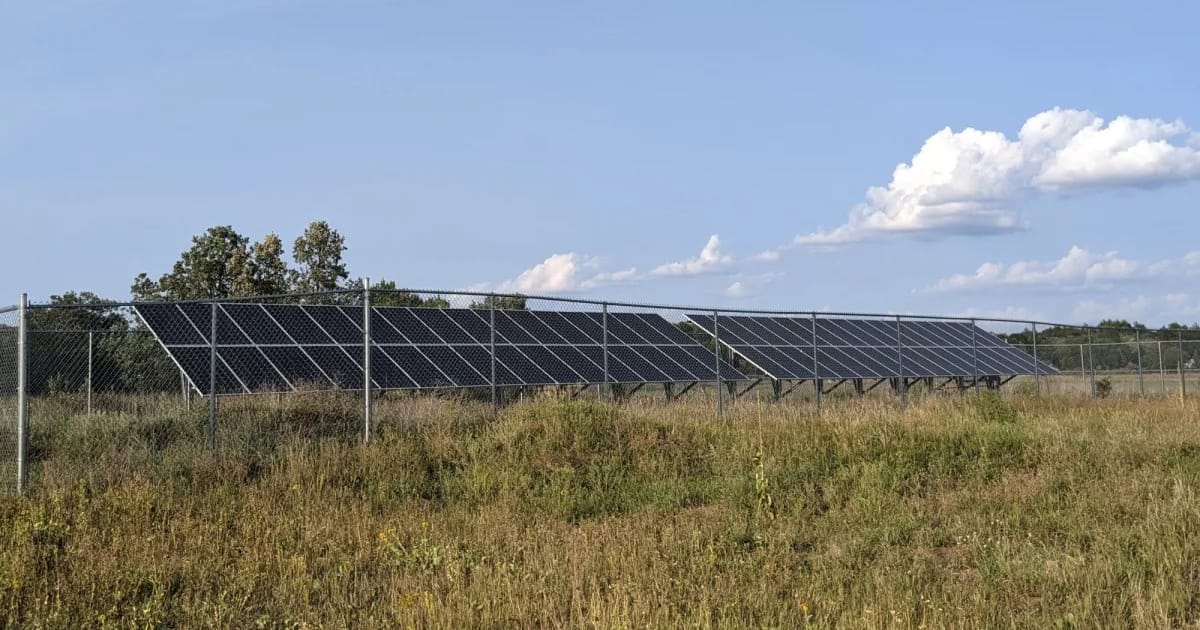Minnesota tribe could soon get a solar-powered resilience hub
November 27, 2024

The Pine Point Resilience Hub would serve an elementary school and community center in Pine Point, an Anishinaabe village of about 330 people on the White Earth Reservation.
In June, the project was selected to receive $1.75 million from the U.S. Department of Energy’s Energy Storage for Social Equity (ES4SE) Program, which helps underserved and frontline communities leverage energy storage to make electricity more affordable and reliable. It’s part of a slew of Biden administration funding related to grid resilience and energy equity that has spurred several tribal microgrid projects across the country.
The developers, locally owned 8th Fire Solar and San Francisco-based 10Power, hope to finish the project next year, and have also secured funding from Minnesota’s Solar for Schools program and foundation grants, but said they still need to raise about $1 million. They’re also counting on receiving about $1.5 million in federal tax credits, which face an uncertain future with the incoming Trump administration.
“The idea of the microgrid is to help with infrastructure,” said Gwe Gasco, a member of the White Earth Nation and the program coordinator with 8th Fire Solar, a thermal solar company based on the reservation.
Tribal communities were largely bypassed during the massive, federally funded push under the Rural Electrification Act of 1936 to bring electricity to remote rural areas of the country. As a result, grid infrastructure on many reservations remains insufficient to this day, with an estimated 1 in 7 Native American households on reservations lacking electricity connections, and many more contending with unreliable service.
On top of higher-than-average electric reliability issues, tribal communities also generally pay higher rates for electricity and face higher energy burdens due to poverty and substandard housing.
On the White Earth Reservation, these challenges are most pronounced in Pine Point, where one-third of residents live in poverty. Gasco said the area is among the first to suffer from outages, with eleven occurring over the last five years, according to the Itasca-Mantrap Electric Cooperative that serves the area.
The Pine Point Resilience Hub project will build on an existing 21-kilowatt solar array, adding another 500 kilowatts of solar capacity along with a 2.76 megawatt-hour battery storage system, enough to provide about 12 hours worth of backup power for residents to be able to charge cell phones, power medical equipment, or stay warm in the event of a power outage.
Gasco said the microgrid could be especially important in the winter, given the area’s “brutally cold” weather and reliance on electric heat. They also hope it will reduce utility costs, though they are still negotiating with the local electric co-op on rates for power the system sends and receives from the utility’s grid. Itasca-Mantrap President and CEO Christine Fox said it doesn’t set net metering rates, which are determined by its electricity supplier.
The project developers hope to qualify for additional federal tax credits by using equipment largely produced in the U.S., including Minnesota-built Heliene solar panels, inverters made in Massachusetts, and Ohio-produced solar racks.
The developers have partnered with the Pine Point School District, which plans to incorporate the microgrid into an Ojibwe-language curriculum on renewable energy. A monitoring interface will allow students to see real-time data in the classroom.
“It’s powerful to me that this [project] is at a school where we’re hoping to inspire the next generation of kids,” said Sandra Kwak, CEO and founder of 10Power, a for-profit company that specializes in developing renewable energy projects in tribal communities.
Corey Orehek, senior business developer for Ziegler Energy Solutions, which has been hired to do the installation, said they plan to work with a local community college to train students for solar jobs.
“One of the things that we want to drive in this is workforce development,” Orehek said. “We want to leave something that’s not only a project that’ll last 30 years but provide the training and experience for community members to either start their own energy companies or become contractors in the clean energy workforce.”
The resilience hub is the second such project announced by a Minnesota tribe in recent months. The Red Lake Nation received $3.15 million from the U.S. Department of Energy’s Local Government Energy Program in late September for a behind-the-meter microgrid project at a secondary school.
The Shakopee Mdewakanton Sioux Community is also working with Minnesota Valley Electric Cooperative to build a $9 million microgrid with U.S. Department of Energy funding. The electric cooperative will install a 4 megawatt-hour energy storage system and add a 1 megawatt solar system at the reservation in suburban Minneapolis.
It’s unclear whether federal funding for such projects will continue in President-elect Trump’s second term, but for now tribal energy advocates see microgrids as a good solution to both lower energy burdens and improve reliability.
“This is a great opportunity to create a success story in terms of leveraging cutting-edge technology, being able to help frontline communities, and for tribes and co-ops to work together,” Kwak said.
Search
RECENT PRESS RELEASES
Related Post



